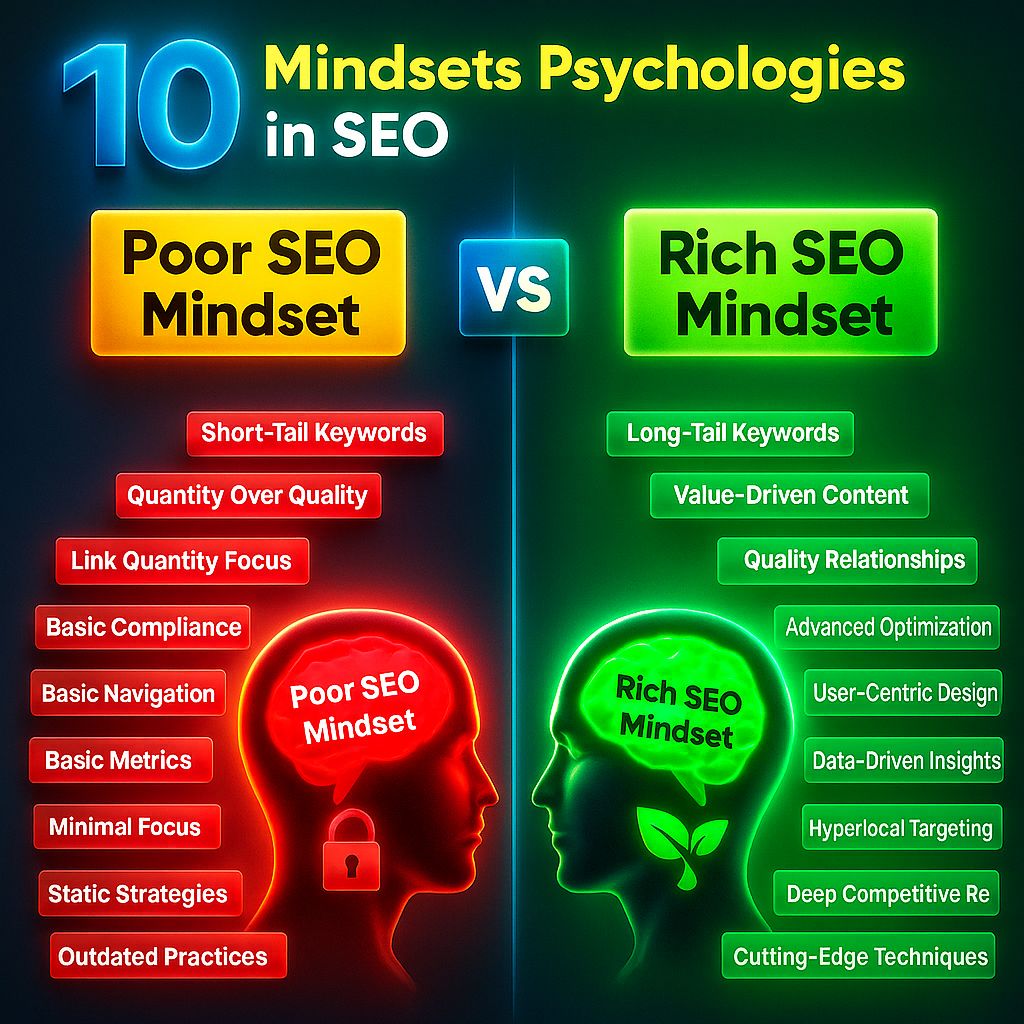Search Engine Optimization (SEO) is not only about keywords, backlinks, or content writing. It’s also about mindset. The way you think about SEO directly impacts your growth, rankings, and revenue.
In this article, we will compare the Poor SEO Mindset vs the Rich SEO Mindset, explain each difference in detail, and show you how to shift your strategy for long-term success.
1. Short-Tail Keywords vs Long-Tail Keywords
- Poor SEO Mindset: Only targets short keywords like “SEO tips” or “buy shoes.” These are very competitive and hard to rank.
- Rich SEO Mindset: Focuses on long-tail keywords like “best SEO tips for beginners in 2025” or “cheap ad network for USA traffic.” These bring less competition, more targeted visitors, and higher conversion rates.
👉 Want to go deeper? Check out our guide on Mastering SEO in 2025.
2. Quantity Over Quality vs Value-Driven Content
- Poor SEO Mindset: Publishes many low-quality articles, hoping at least some will rank.
- Rich SEO Mindset: Writes valuable, in-depth content that solves user problems. Google rewards websites that deliver real value to readers.
3. Link Quantity Focus vs Quality Relationships
- Poor SEO Mindset: Buys backlinks in bulk, even from spammy sites.
- Rich SEO Mindset: Builds quality relationships with niche bloggers, guest posting, and earning editorial backlinks that last longer.
4. Basic Compliance vs Advanced Optimization
- Poor SEO Mindset: Only follows the minimum rules, like adding titles and descriptions.
- Rich SEO Mindset: Goes beyond basics — schema markup, Core Web Vitals, internal linking strategy, and optimized site architecture.
5. Basic Navigation vs User-Centric Design
- Poor SEO Mindset: Keeps a simple menu without thinking about user experience.
- Rich SEO Mindset: Designs a site that’s easy to navigate, fast, mobile-friendly, and enjoyable for the visitor.
👉 If you are planning to monetize, also read how to run native ads on MGID with the right targeting.
6. Basic Metrics vs Data-Driven Insights
- Poor SEO Mindset: Only looks at traffic numbers in Google Analytics.
- Rich SEO Mindset: Uses data-driven insights like bounce rate, heatmaps, session duration, and user journey to optimize every detail.
7. Minimal Focus vs Hyperlocal Targeting
- Poor SEO Mindset: Targets broad audiences with little focus.
- Rich SEO Mindset: Uses hyperlocal targeting like “Best ad network for bloggers in New York” — this brings highly engaged and profitable traffic.
8. Static Strategies vs Deep Competitive Research
- Poor SEO Mindset: Follows the same SEO routine every year without updates.
- Rich SEO Mindset: Analyzes competitors, learns their backlink strategies, and identifies content gaps to stay ahead.
👉 Example: before running ads, study the competition with this guide on best & cheap ad networks.
9. Outdated Practices vs Cutting-Edge Techniques
- Poor SEO Mindset: Still uses outdated tricks like keyword stuffing or spammy directory links.
- Rich SEO Mindset: Adopts modern techniques like topical authority, E-E-A-T (Experience, Expertise, Authority, Trust), and AI content optimization.
10. Poor SEO = Locked Growth vs Rich SEO = Scalable Growth
- Poor SEO Mindset keeps your growth locked because you focus on shortcuts.
- Rich SEO Mindset opens the door to scalable growth, more organic traffic, and higher revenue from AdSense, AdX, or affiliate marketing.
👉 If your goal is growth, check how to get millions of visitors from Tier 1 countries using smart strategies.
Final Thoughts
SEO is more than just technical rules — it’s about thinking long-term. If you stick to the Poor SEO Mindset, you’ll stay stuck with limited results. But if you adopt the Rich SEO Mindset, you can achieve consistent growth, higher rankings, and more revenue.
